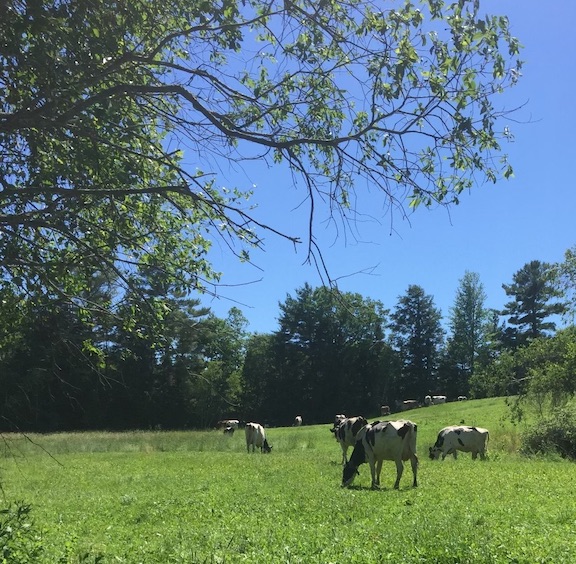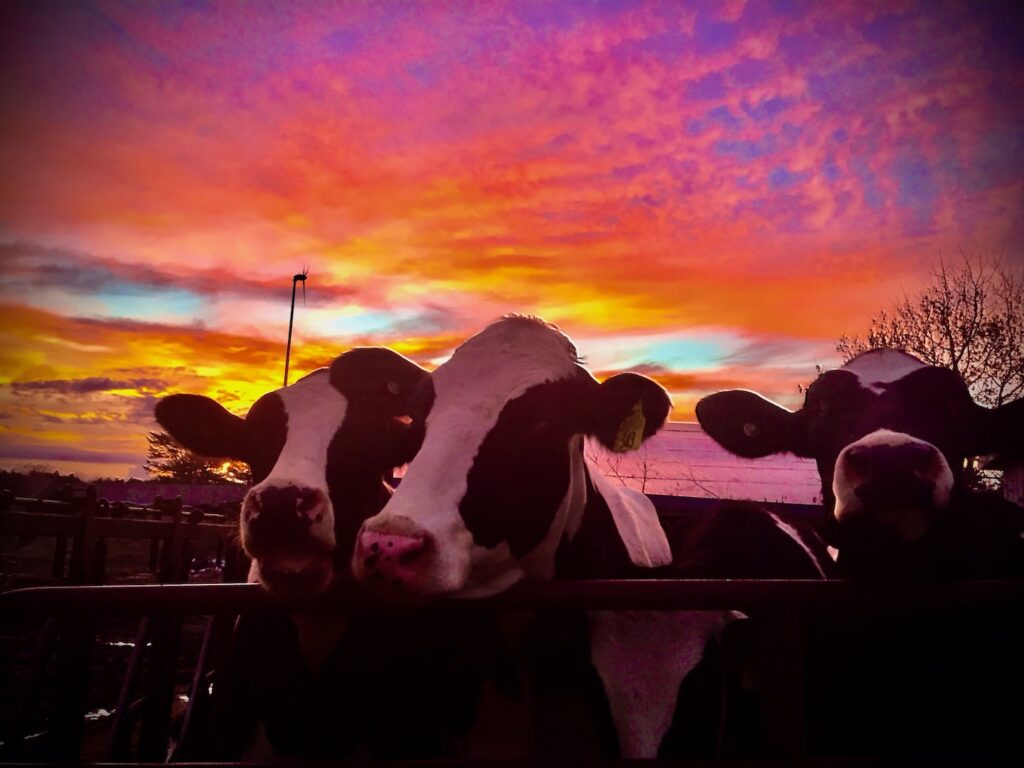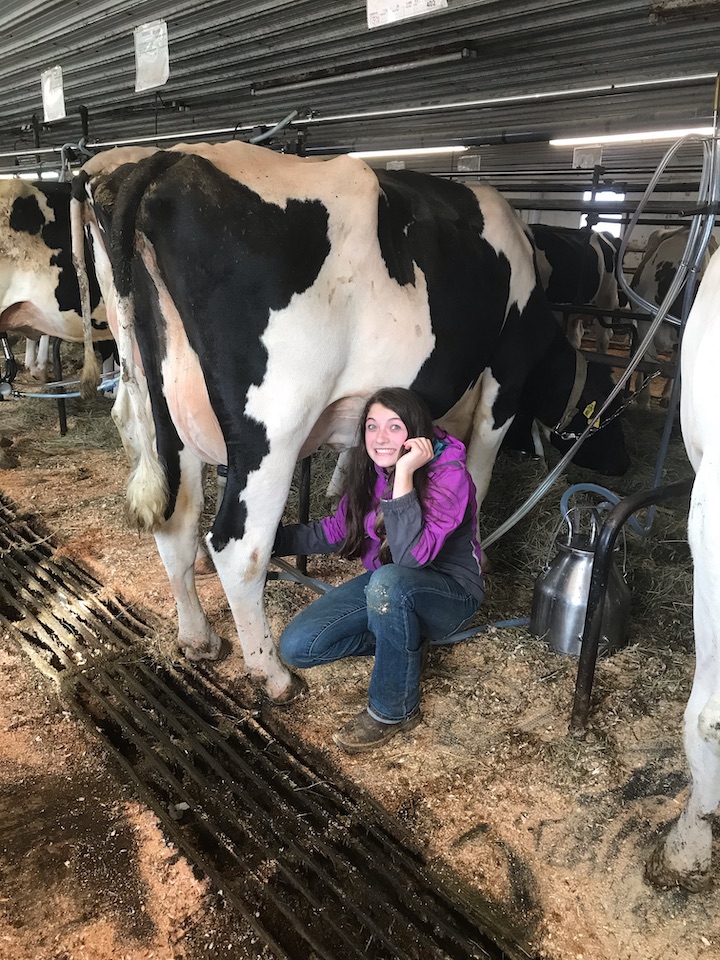Family Farming at Silver Valley Farm
By Sonja Heyck-Merlin
In August of 2021, Horizon Organic, owned by the French company Danone, terminated its contracts with 14 organic dairy farms in Maine. Silver Valley Farm in New Sharon was one. Horizon gave them 12 months to find a new buyer; later it extended that by six months. Horizon delivered the same news to its producers in New Hampshire, Vermont and some in New York, for a total of 89 terminated contracts in the Northeast. The timing couldn’t have been worse for Silver Valley — brothers, Jim and Jeff Davis, and their cousin, Rick Davis, were close to sealing the deal on the purchase of Silver Valley, marking a transition from the third to fourth generation.

“Obviously, it was a do or die thing. Either we would find a new buyer for the milk or we would have to be done. There was no other viable option for us,” says Jim. The trio at Silver Valley milks 50 Holsteins and four Brown Swiss, with a daily production average of 67 pounds per cow (wholesale milk is measured in pounds). Every single day of the year, the farm produces about 3,600 pounds of milk, or 420 gallons. Production of this level demands a wholesale buyer. A buyer, like Horizon, who can guarantee that every other day a tanker will back into the driveway and haul the milk to a processor.
The end of 2021 and the beginning of 2022 were stressful for Jim, Jeff and Rick; they questioned their decision to purchase the farm but remained hopeful that another processor would step forward. The options are limited: Stonyfield Organic (owned by the French company Lactalis) and Wisconsin-based Organic Valley are the only other buyers of wholesale, organic milk in Maine. Finally, in March of 2022, Organic Valley announced it would take on most of the stranded Horizon producers, including Silver Valley Farm. A week after the announcement, coincidentally, Jim, Jeff and Rick completed the farm purchase.

Their 350 acres are bisected by state Route 27. South of the road are the buildings, including a tie-stall barn and a heifer barn, and 100 acres of pasture. On the north side of the road, where they have another 150 open acres, the land has been shaped by the sweeping curves of the Sandy River. The river is responsible for the deep, sandy loam soil. Rick says, “We definitely have some good land to work. I can drop a plow and never hit a rock all day.”
The river also offers some unpredictability: In 2000, an oxbow formed, turning 50 acres of prime land into an island. It took years to get approval to build a tractor laneway across the river. In order to produce enough forage for the cows, they lease an additional 100 acres of fields.
Jim, Jeff and Rick’s lives, too, were shaped by the river and the farm, swept into the current of dairy chores as children. They watched and learned from their parents, a pattern that began in the 1940s when their great-grandparents purchased the farm and raised Herefords and vegetables. The second generation pivoted from beef and started milking Holsteins. Most of the cows in the herd, which was transitioned to organic in 2007, are the descendants of that original herd.
Between Jim, Jeff and Rick, they have seven kids — the fifth generation. It’s not a given that one of the kids will eventually take over the farm, but it seems possible. They each move about the farm in their own way, from strollers to tractor seats. Jim’s kids, Samantha, 14, James Jr.,12, and Sophia, 11, help with milking and barn chores. Samantha is the best skidsteer operator on the farm, according to Jim. All three are also active 4-H participants, showing animals they’ve raised across the state. Jim credits his wife for his ability to farm and provide these experiences for the kids. “From running errands, to coming in when I need a hand milking or feeding calves, right down to working her hospital office job, earning good money, so that I can afford to farm,” he says.
At 4 and 7, Jeff’s girls are younger but already know the rhythms of farm life. Rick’s kids are the oldest — his 22-year-old daughter lives off the farm with her fiance and baby, and Alex,18, works construction but lends a hand whenever he can.
Farming with family is challenging, Jim and Rick admit. “I try to keep a cool level head when talking to family, but sometimes it’s easier said than done,” Jim says. Rick mirrored his cousin, saying, “I try to stay patient. It can be really difficult sometimes. We get hotheaded from time to time.”

To help mitigate conflict, they use a division of labor. Each has their own niche — Jim manages the cows and does the majority of the milking, Rick repairs the equipment and puts up feed and Jeff helps with breeding, feeding and evening milkings.
Jim spends a lot of his time in the milking barn, a tie-stall completed by his dad and uncle in 1987. They also raise their calves in groups in this barn. Since they have about 60 milk cows all together, including dry cows, roughly 30 female calves are born each year. Once weaned, they’re moved to the bedded pack heifer barn. Jim would love to build a calf barn. “If money was never an issue, we would have one,” he says. “Money is always the issue.”
The family doesn’t have organized meetings; communication and impromptu planning occur in the tie-stall. The barn is long and narrow with dozens of windows on each side. The cows are clipped into two rows of stalls facing each other. A stainless steel pipeline runs above where the farmers connect each of their four milking machines, moving up one side of the barn as they milk and then down the other.
Each generation has made significant changes to the farm: this one dreams of building a freestall. In a freestall, a cow can move between bedded stalls and a feed alley. The typical milking system accompanying a freestall is a milking parlor, where the people milking stand in a deep pit as groups of cows get rotated through the parlor. Because of the cost of a parlor, they plan to build the freestall and continue to milk in the tie-stall.
During the grazing season, the cows are only in the barn during milkings, which are at 5:30 a.m. and 4 p.m. In the winter, they spend the majority of their time in their stalls but each afternoon loaf outside for a few hours in an adjacent 80-by-60-foot concrete high-use area. Here they have access to round bales of baleage from feed wagons.
In the tie-stall, they feed the milk cows a combination of purchased organic grain, corn silage and round bales of dry hay. “We have an electric cart that we use to feed out silage and put grain on top of that. Once they eat their grain, we roll out a round bale of dry hay the length of the barn,” says Jim. The amount of grain fed per cow depends on the stage of lactation; high-producing cows making upwards of 100 pounds of milk per day get 20 pounds of grain. The lowest producers get 10 pounds.
Come mid-May, when the pastures firm and green up, the herd is let out immediately after milkings. The milk cows are rotated between seven permanent pastures, averaging 14 acres each. They remain on one of these pastures for 7 to 16 days. The pasture is supplemented with baleage, dry hay and corn silage fed on the high-use area, where the cows also access water. The young stock have a separate pasture rotation.
The ease that comes with pasture season — less feeding up in the barn, less stall scraping and less manure management — also begins the race to put up the next winter’s feed. This is Rick’s bailiwick. “I started baling hay when I was seven. I always wanted to be out in the field,” Rick says. Alex, his son, also loves field work, rushing home from his construction job to hop on the mower or baler. Rick is also responsible for all of the equipment maintenance and does most of the major repairs out of his neighbor’s shop. Jim says he is grateful that he can just turn a key when he hops into a tractor.
In the spring, as soon as their ground is firm, they start spreading cow manure from the stacking pad near the tie-stall. Putting up high-quality dairy feed requires more fertility than the cows produce, so they’ve historically used conventional hen manure as a fertilizer, particularly important for the 20 acres of corn they chop as silage. Every three years, based on the performance of individual hay fields, they spread a light dose of hen manure on fields that need a fertility boost.
According to Rick, this manure source is jeopardized as large egg producers pull out of Maine. He feels fortunate he got his hands on twelve 30-ton loads this year, most of which will be used on the corn ground at a rate of one load per 4 acres. Without this source of nutrients, Ricks says, “It’s going to be a real challenge for organic growers. We’re going to have to have something for nitrogen.” Without the hen manure, Rick thinks it’s impossible to keep growing corn.
Once the fields are spread, the mad dash for high-quality forages begins; hopefully their New Holland Discbine is humming along by May 20. The farm has won quite a few awards for their forages. First and second crops are put up as round bales of baleage (1,000 on average) or as dry hay (400 on average), while third and fourth crops get chopped and packed into bunker silos. The chopped grass gets packed down, to keep out oxygen, in these tall, three-sided concrete structures and is then covered with a large tarp. “Our bunker silos are original to my great-grandfather and another one of those infrastructure things we would love to be able to update,” Ricks says. Currently, they pack 400 to 500 tons of haylage into the outdated bunks.
The first crop hustle is punctuated by reseeding the previous year’s corn ground to forage and planting the new corn crop. Sometimes Rick will grow corn on the same parcel for two years in a row, but only if the mustard weed pressure was low in the previous season. Mustard is the bane of growing corn, Rick says. To return a field from corn to hay, Rick plows with a John Deere 2700 moldboard plow, discs, and seeds a nurse crop of oats or barley, which will shade and protect the small grass and alfalfa plants he is trying to establish. Next, he runs across the field with a Perfecta spring-tine harrow before dropping the grass and alfalfa seed into long, straight rows with a Brillion seeder.
Lately, he’s been planting 80% alfalfa and 20% mixed grass forage. “I am getting more and more into alfalfa,” Rick says. “Any year could be the last year of hen manure, and I would like to have the established alfalfa to make up what we’ll lose with the corn.” Since he has some manure for 2022, he’ll plant 20 acres of corn, which will get chopped and packed on top of the fourth crop haylage already in the bunk. The corn grows reliably in the absence of mustard but requires four rounds of cultivation with a four-row Lilliston-style cultivator.
As Jim, Jeff and Rick plan for the 2022 cropping and forage season, it’s difficult to ignore the rising costs of seed, bale wrap, net wrap, diesel fuel and grain. “Stuff is getting ridiculous,” Ricks says. As wholesale producers, the price paid by the processor does not increase to compensate for the rising costs of production. The pay price is out of these farmers’ hands.
One way to compensate for rising costs is to increase efficiency, but that requires expensive investments on a farm of this scale. Rick would love to speed up how they feed the cows by purchasing a mixing wagon — a large, PTO-driven machine with vertical augers, which can mix haylage (or baleage), corn silage and grain together. A mixing wagon is towed behind a tractor and spits the feed off a conveyor into a feed ally. Even a used one costs around $35,000. And then there’s the barn that everyone is dreaming of.
Small organic farms, like Silver Valley, face another threat — an oversupply of organic milk. In early 2022, according to The New York Times, a glut of milk from mega dairies in western states contributed to keeping the price of organic milk low. Such an oversupply of milk reduces the chances of an increase in pay price, which directly impacts Silver Valley’s ability to make improvements.
On March 29, 2022, the USDA strengthened the organic standards for organic livestock producers by publishing a final Origin of Livestock Rule. Now established organic dairies can no longer continually transition in non-organic animals.
Jim, Jeff and Rick are committed to dairy farming despite the uncertainties, new infrastructure or not. They’re grateful Organic Valley stepped in. “There are days when you love it, and days when you wonder why you’re doing it,” says Jim. “It’s definitely nice to be with family and to be able to see the beauty in the world — just being able to see those sorts of things and not be stuck in an office.”
About the author: Sonja Heyck-Merlin is a regular feature writer for The MOF&G. She and her family own and operate an organic dairy farm in Charleston, Maine.
This article was originally published in the summer 2022 issue of The Maine Organic Farmer & Gardener.
